ON ATTILA THE HUN
Attila
From Wikipedia, the free encyclopedia
"Atilla" and "Attila the Hun" redirect here. For other uses, see Attila (disambiguation), Atilla (disambiguation), and Attila the Hun (disambiguation).
| Attila | |
|---|---|
| Ruler of the Hunnic Empire | |

Allegorical depiction by Eugène Delacroix(1843–1847)
| |
| Reign | 434–453 |
| Predecessor | Bleda and Ruga |
| Successor | Ellac, Dengizich, Ernak |
| Born | c. 406[1]:208[2]:202 |
| Died | March 453 |
| Consort | Kreka Ildico |
| Father | Mundzuk |
Attila (/ˈætᵻlə/ or /əˈtɪlə/; fl. circa 406–453), frequently referred to as Attila the Hun, was the ruler of the Huns from 434 until his death in March 453. Attila was a leader of the Hunnic Empire, a tribal confederation consisting of Huns, Ostrogoths, and Alansamong others, on the territory of Central and Eastern Europe.
During his reign, he was one of the most feared enemies of the Western and Eastern Roman Empires. He crossed the Danube twice and plundered the Balkans, but was unable to take Constantinople. His unsuccessful campaign in Persia was followed in 441 by an invasion of the Eastern Roman (Byzantine) Empire, the success of which emboldened Attila to invade the West.[3] He also attempted to conquer Roman Gaul (modern France), crossing the Rhine in 451 and marching as far as Aurelianum (Orléans) before being defeated at the Battle of the Catalaunian Plains.
He subsequently invaded Italy, devastating the northern provinces, but was unable to take Rome. He planned for further campaigns against the Romans but died in 453. After Attila's death his close adviser Ardaric of the Gepids led a Germanic revolt against Hunnic rule, after which the Hunnic Empire quickly collapsed.
Contents
[hide]Appearance and character
There is no surviving first-hand account of Attila's appearance, but there is a possible second-hand source provided by Jordanes, who cites a description given by Priscus.[4][5]
Some modern scholars have suggested that this description is typically East Asian, because it has all the combined features that fit the physical type of people from Eastern Asia, and Attila's ancestors may have come from there.[5][7]:202
Etymology
Otto J. Maenchen-Helfen considered an East Germanic origin; Attila is formed from Gothic or Gepidic noun atta, "father", by means of the diminutive suffix -ila,[9]:386 meaning "little father".[10] The Gothic etymology can be tracked up to Jacob Grimm and Wilhelm Grimm in the early 19th century.[10] Maenchen-Helfen noted that Hunnic names were "not the true names of the Hun princes and lords. What we have are Hunnic names in Germanic dress, modified to fit the Gothic tongue, or popular Gothic etymologies, or both".[9]:389Peter Heather, who strongly considered Germanic etymology of the name Attila and some of noble Huns,[8]:29–30, 177 stated that the possibility Attila was of Germanic ancestry cannot be ruled out.[11] The names of Attila's brother Bleda, and most powerful minister Onegesius, also have hypothetical Germanic etymology. Only credible Germanic etymology have Attila's blood relative Laudaricus,[9]:388 and certain Hun-Goth Ragnaris.[9]:383, 389
Hyun Jin Kim argued that the "Germanization of Hunnic names may have been a conscious policy among the Hunnic elite in the West in order to ease the transition to their rule of formerly independent German tribal unions".[8]:93 In the Western part of Hunnic Empire, where mostly lived subjected Gothic tribes, Huns probably spoke both Hunnic and Gothic language, and as such bore Germanized or Germanic name, like Laudaricus.[8]:30 Maenchen-Helfen also expressed concern over orthography of the writer, possible morphological change, that some names writers heard from the Goths, the tendency of Roman and Byzantine writers to alter foreign names, and manuscript corruption.[9]:381–382
However, Kim noted that those names considered by Heather to be Gothic, especially in this case of Attila and Bleda, have more natural and probable Turkic etymology.[8]:30Heather also ignored the fact that all Hunnic rulers before Attila, as well his father Mundzuk, paternal uncles Octar, Ruga and Oebarsius, wife Kreka, father-in-law Eskam, and sons Ellac, Dengizich and Ernak, have names of Turkic origin.[8]:30
Omeljan Pritsak considered ̕Άττίλα (Atilla) a composite title-name which derived from Turkic *es (great, old), and *t il (sea, ocean), and the suffix /a/.[12]:444 The stressed back syllabic til assimilated the front member es, so it became *as.[12]:444 It is a nominative, in form of attíl- (< *etsíl < *es tíl) with the meaning "the oceanic, universal ruler".[12]:444 Peter Golden, citing Pritsak, like László Rásonyi connected Attila's name with Menander note in which used term Attilan as the name of the Volga River (Turkic Atil/Itil; "great river").[13]:90[14] J.J. Mikkola connected it with Turkic āt (name, fame).[10] Gerd Althoff considered it was related to Turkish atli (horseman, cavalier), or Turkish at (horse) and dil(tongue).[10]
Tom Shippey in his work Goths and Huns: The Rediscovery of Northern Cultures in the Nineteenth Century (1982), argued that the Gothic etymology is a product of 19th century Germanic romantic philological revisionism.[8]:177
M. Snædal casts doubt on the Germanic origin of the name Attila in a recently published article. "The Gothic origin of the name Attila is questionable," Snædal writes. "It is at least as likely to be of Hunnic origin". The article points out that the word atta is a migratory term for "father/forefather" common in multiple languages, including many Turkic languages (see Ata). The article also indicates that Attila's name could have originated from Turkic-Mongolian at, adyy/agta (gelding, warhorse) and Turkish atli (horseman, cavalier), meaning "possessor of geldings, provider of warhorses", a suitable name for a warlord. He concludes:
The name has many variants in several languages: Atli and Atle in Old Norse; Etzel in Middle High German (Nibelungenlied); Ætla in Old English; Attila, Atilla, and Etele inHungarian (Attila is the most popular); Attila, Atilla, Atilay, or Atila in Turkish; and Adil and Edil in Kazakh or Adil ("same/similar") or Edil ("to use") in Mongolian.
Historiography and source
The historiography of Attila is faced with a major challenge, in that the only complete sources are written in Greek and Latin by the enemies of the Huns. Attila's contemporaries left many testimonials of his life, but only fragments of these remain.[15]:25 Priscus was a Roman diplomat and historian who wrote in Greek, and he was both a witness to and an actor in the story of Attila, as a member of the embassy ofTheodosius II at the Hunnic court in 449. He was obviously biased by his political position, but his writing is a major source for information on the life of Attila, and he is the only person known to have recorded a physical description of him. He wrote a history of the late Roman Empire in eight books covering the period from 430 to 476.[16]
Today we have only fragments of Priscus' work, but it was cited extensively by 6th-century historians Procopius and Jordanes,[17]:413especially in Jordanes' The Origin and Deeds of the Goths. It contains numerous references to Priscus's history, and it is also an important source of information about the Hunnic empire and its neighbors. He describes the legacy of Attila and the Hunnic people for a century after Attila's death. Marcellinus Comes, a chancellor of Justinian during the same era, also describes the relations between the Huns and theEastern Roman Empire.[15]:30
Numerous ecclesiastical writings contain useful but scattered information, sometimes difficult to authenticate or distorted by years of hand-copying between the 6th and 17th centuries. The Hungarian writers of the 12th century wished to portray the Huns in a positive light as their glorious ancestors, and so repressed certain historical elements and added their own legends.[15]:32
The literature and knowledge of the Huns themselves was transmitted orally, by means of epics and chanted poems that were handed down from generation to generation.[17]:354 Indirectly, fragments of this oral history have reached us via the literature of the Scandinavians and Germans, neighbors of the Huns who wrote between the 9th and 13th centuries. Attila is a major character in many Medieval epics, such as the Nibelungenlied, as well as various Eddas and sagas.[15]:32[17]:354
Archaeological investigation has uncovered some details about the lifestyle, art, and warfare of the Huns. There are a few traces of battles and sieges, but today the tomb of Attila and the location of his capital have not yet been found.[15]:33–37
Early life and background
Main article: Huns
The Huns were a group of Eurasian nomads, appearing from east of the Volga, who migrated into Europe c. 370[18] and built up an enormous empire there. Their main military techniques were mounted archery and javelin throwing. They were possibly the descendants of the Xiongnu (Hsiung-nu) who had been northern neighbors of China three hundred years before and may be the first expansion of Turkic people across Eurasia.[19][20][21] They were in the process of developing settlements before their arrival in Europe, yet the Huns were a society of pastoral warriors[17]:259 whose primary form of nourishment was meat and milk, products of their herds.
The origin and language of the Huns has been the subject of debate for centuries. According to some theories, their leaders at least may have spoken a Turkic language, perhaps closest to the modern Chuvash language.[12]:444 One scholar suggests a relationship to Yeniseian.[22] According to the Encyclopedia of European Peoples, "the Huns, especially those who migrated to the west, may have been a combination of central Asian Turkic, Mongolic, and Ugric stocks".[23]
Attila's father Mundzuk was the brother of kings Octar and Ruga, who reigned jointly over the Hunnic empire in the early fifth century. This form of diarchy was recurrent with the Huns, but historians are unsure whether it was institutionalized, merely customary, or an occasional occurrence.[15]:80 His family was from a noble lineage, but it is uncertain whether they constituted a royal dynasty. Attila's birthdate is debated, journalist Éric Deschodt and writer Herman Schreiber have proposed a date of 395.[24][25] However, historian Iaroslav Lebedynsky and archaeologist Katalin Escher prefer an estimate between the 390s and the first decade of the fifth century.[15]:40 Several historians have proposed 406 as the date.[1]:92[2]:202
Attila grew up in a rapidly changing world. His people were nomads who had only recently arrived in Europe.[26] They crossed the Volga river during the 370s and annexed the territory of the Alans, then attacked the Gothic kingdom between the Carpathian mountains and the Danube. They were a very mobile people, whose mounted archers had acquired a reputation of invincibility, and the Germanic tribes seemed unable to withstand them.[17]:133–151 Vast populations fleeing the Huns moved from Germania into the Roman Empire in the west and south, and along the banks of the Rhine and Danube. In 376, the Goths crossed the Danube, initially submitting to the Romans but soon rebelling against Emperor Valens, whom they killed in the Battle of Adrianople in 378.[17]:100 Large numbers of Vandals, Alans, Suebi, and Burgundians crossed the Rhine and invaded Roman Gaul on December 31, 406 to escape the Huns.[15]:233 The Roman Empire had been split in half since 395 and was ruled by two distinct governments, one based inRavenna in the West, and the other in Constantinople in the East. The Roman Emperors, both East and West, were generally from the Theodosian family in Attila's lifetime (despite several power struggles).[27]:13
The Huns dominated a vast territory with nebulous borders determined by the will of a constellation of ethnically varied peoples. Some were assimilated to Hunnic nationality, whereas many retained their own identities and rulers but acknowledged the suzerainty of the king of the Huns.[27]:11 The Huns were also the indirect source of many of the Romans' problems, driving various Germanic tribes into Roman territory, yet relations between the two empires were cordial: the Romans used the Huns as mercenaries against the Germans and even in their civil wars. Thus, the usurper Joannes was able to recruit thousands of Huns for his army against Valentinian III in 424. It was Aëtius, later Patrician of the West, who managed this operation. They exchanged ambassadors and hostages, the alliance lasting from 401 to 450 and permitting the Romans numerous military victories.[17]:111 The Huns considered the Romans to be paying them tribute, whereas the Romans preferred to view this as payment for services rendered. The Huns had become a great power by the time that Attila came of age during the reign of his uncle Ruga, to the point that Nestorius, the Patriarch of Constantinople, deplored the situation with these words: "They have become both masters and slaves of the Romans".[17]:128
Campaigns against the Eastern Roman Empire
The death of Ruga (also known as Rua or Ruga) in 434 left the sons of his brother Mundzuk, Attila and Bleda, in control of the united Hun tribes. At the time of the two brothers' accession, the Hun tribes were bargaining with Eastern Roman Emperor Theodosius II's envoys for the return of several renegades who had taken refuge within the Eastern Roman Empire, possibly Hunnic nobles who disagreed with the brothers' assumption of leadership.
The following year, Attila and Bleda met with the imperial legation at Margus (Požarevac), all seated on horseback in the Hunnic manner,[28] and negotiated a successful treaty. The Romans agreed to return the fugitives, to double their previous tribute of 350 Roman pounds (c. 115 kg) of gold, to open their markets to Hunnish traders, and to pay a ransom of eight solidi for each Roman taken prisoner by the Huns. The Huns, satisfied with the treaty, decamped from the Roman Empire and returned to their home in theGreat Hungarian Plain, perhaps to consolidate and strengthen their empire. Theodosius used this opportunity to strengthen the walls of Constantinople, building the city's first sea wall, and to build up his border defenses along the Danube.
The Huns remained out of Roman sight for the next few years while they invaded the Sassanid Empire. They were defeated inArmenia by the Sassanids, abandoned their invasion, and turned their attentions back to Europe. In 440, they reappeared in force on the borders of the Roman Empire, attacking the merchants at the market on the north bank of the Danube that had been established by the treaty.
Crossing the Danube, they laid waste to the cities of Illyricum and forts on the river, including (according to Priscus) Viminacium, a city of Moesia. Their advance began at Margus, where they demanded that the Romans turn over a bishop who had retained property that Attila regarded as his. While the Romans discussed the bishop's fate, he slipped away secretly to the Huns and betrayed the city to them.
While the Huns attacked city-states along the Danube, the Vandals (led by Geiseric) captured the Western Roman province of Africa and its capital of Carthage. Carthage was the richest province of the Western Empire and a main source of food for Rome. The Sassanid Shah Yazdegerd II invaded Armenia in 441.
The Romans stripped the Balkan area of forces, sending them to Sicily in order to mount an expedition against the Vandals in Africa. This left Attila and Bleda a clear path through Illyricum into the Balkans, which they invaded in 441. The Hunnish army sacked Margus and Viminacium, and then took Singidunum (Belgrade) and Sirmium. During 442, Theodosius recalled his troops from Sicily and ordered a large issue of new coins to finance operations against the Huns. He believed that he could defeat the Huns and refused the Hunnish kings' demands.
Attila responded with a campaign in 443.[29] The Huns were equipped with new military weapons as they advanced along the Danube, such as battering rams and rolling siege towers, and they overran the military centers of Ratiara and successfully besieged Naissus (Niš).
Advancing along the Nišava River, the Huns next took Serdica (Sofia), Philippopolis (Plovdiv), and Arcadiopolis (Lüleburgaz). They encountered and destroyed a Roman army outside Constantinople but were stopped by the double walls of the Eastern capital. They defeated a second army near Callipolis (Gelibolu).
Theodosius, stripped of his armed forces, admitted defeat, sending the Magister militum per Orientem Anatolius to negotiate peace terms. The terms were harsher than the previous treaty: the Emperor agreed to hand over 6,000 Roman pounds (c. 2000 kg) of gold as punishment for having disobeyed the terms of the treaty during the invasion; the yearly tribute was tripled, rising to 2,100 Roman pounds (c. 700 kg) in gold; and the ransom for each Roman prisoner rose to 12 solidi.
Their demands were met for a time, and the Hun kings withdrew into the interior of their empire. Bleda died following the Huns' withdrawal from Byzantium (probably around 445). Attila then took the throne for himself, becoming the sole ruler of the Huns.[30]
Solitary kingship
In 447, Attila again rode south into the Eastern Roman Empire through Moesia. The Roman army, under Gothic magister militumArnegisclus, met him in the Battle of the Utus and was defeated, though not without inflicting heavy losses. The Huns were left unopposed and rampaged through the Balkans as far as Thermopylae.
Constantinople itself was saved by the Isaurian troops of magister militum per Orientem Zeno and protected by the intervention of prefect Constantinus, who organized the reconstruction of the walls that had been previously damaged by earthquakes and, in some places, to construct a new line of fortification in front of the old. An account of this invasion survives:
In the west
In 450, Attila proclaimed his intent to attack the Visigoth kingdom of Toulouse by making an alliance with Emperor Valentinian III. He had previously been on good terms with the Western Roman Empire and its influential general Flavius Aëtius. Aëtius had spent a brief exile among the Huns in 433, and the troops that Attila provided against the Goths and Bagaudae had helped earn him the largely honorary title of magister militum in the west. The gifts and diplomatic efforts of Geiseric, who opposed and feared the Visigoths, may also have influenced Attila's plans.
However, Valentinian's sister was Honoria, who had sent the Hunnish king a plea for help—and her engagement ring—in order to escape her forced betrothal to a Roman senator in the spring of 450. Honoria may not have intended a proposal of marriage, but Attila chose to interpret her message as such. He accepted, asking for half of the western Empire as dowry.
When Valentinian discovered the plan, only the influence of his mother Galla Placidia convinced him to exile Honoria, rather than killing her. He also wrote to Attila, strenuously denying the legitimacy of the supposed marriage proposal. Attila sent an emissary toRavenna to proclaim that Honoria was innocent, that the proposal had been legitimate, and that he would come to claim what was rightfully his.
Attila interfered in a succession struggle after the death of a Frankish ruler. Attila supported the elder son, while Aëtius supported the younger. (The location and identity of these kings is not known and subject to conjecture.) Attila gathered his vassals—Gepids, Ostrogoths, Rugians, Scirians, Heruls, Thuringians, Alans, Burgundians, among others–and began his march west. In 451, he arrived in Belgica with an army exaggerated by Jordanes to half a million strong.
On April 7, he captured Metz. Other cities attacked can be determined by the hagiographic vitae written to commemorate their bishops: Nicasius was slaughtered before the altar of his church in Rheims; Servatus is alleged to have saved Tongeren with his prayers, as Saint Genevieve is said to have saved Paris.[31] Lupus, bishop of Troyes, is also credited with saving his city by meeting Attila in person.[3][32]
Aëtius moved to oppose Attila, gathering troops from among the Franks, the Burgundians, and the Celts. A mission by Avitus and Attila's continued westward advance convinced the Visigoth king Theodoric I (Theodorid) to ally with the Romans. The combined armies reached Orléans ahead of Attila, thus checking and turning back the Hunnish advance. Aëtius gave chase and caught the Huns at a place usually assumed to be near Catalaunum (modern Châlons-en-Champagne).
The two armies clashed in the Battle of the Catalaunian Plains, the outcome of which is commonly considered to be a strategic victory for the Visigothic-Roman alliance. Theodoric was killed in the fighting, and Aëtius failed to press his advantage, according to Edward Gibbon and Edward Creasy, because he feared the consequences of an overwhelming Visigothic triumph as much as he did a defeat. From Aëtius' point of view, the best outcome was what occurred: Theodoric died, Attila was in retreat and disarray, and the Romans had the benefit of appearing victorious.
Invasion of Italy and death
Attila returned in 452 to renew his marriage claim with Honoria, invading and ravaging Italy along the way. The city of Venicewas founded as a result of these attacks when the residents fled to small islands in the Venetian Lagoon. His army sacked numerous cities and razed Aquileia so completely that it was afterwards hard to recognize its original site.[33]:159 Aëtius lacked the strength to offer battle, but managed to harass and slow Attila's advance with only a shadow force. Attila finally halted at the River Po. By this point, disease and starvation may have taken hold in Attila's camp, thus helping to stop his invasion.[citation needed]
Emperor Valentinian III sent three envoys, the high civilian officers Gennadius Avienus and Trigetius, as well as the Bishop of Rome Leo I, who met Attila at Mincio in the vicinity of Mantua and obtained from him the promise that he would withdraw from Italy and negotiate peace with the Emperor.[34] Prosper of Aquitaine gives a short description of the historic meeting, but gives all the credit to Leo for the successful negotiation. Priscus reports that superstitious fear of the fate of Alaric gave him pause—as Alaric died shortly after sacking Rome in 410.
Italy had suffered from a terrible famine in 451 and her crops were faring little better in 452. Attila's devastating invasion of the plains of northern Italy this year did not improve the harvest.[33]:161 To advance on Rome would have required supplies which were not available in Italy, and taking the city would not have improved Attila's supply situation. Therefore, it was more profitable for Attila to conclude peace and retreat back to his homeland.[33]:160–161
Furthermore, an East Roman force had crossed the Danube under the command of another officer also named Aetius—who had participated in the Council of Chalcedon the previous year—and proceeded to defeat the Huns who had been left behind by Attila to safeguard their home territories. Attila, hence, faced heavy human and natural pressures to retire "from Italy without ever setting foot south of the Po".[33]:163 As Hydatius writes in his Chronica Minora:
Death
Marcian was the successor of Theodosius, and he had ceased paying tribute to the Huns in late 450 while Attila was occupied in the west. Multiple invasions by the Huns and others had left the Balkans with little to plunder.[citation needed] After Attila left Italy and returned to his palace across the Danube, he planned to strike at Constantinople again and reclaim the tribute which Marcian had stopped. However, he died in the early months of 453.
The conventional account from Priscus says that Attila was at a feast celebrating his latest marriage, this time to the beautiful young Ildico (the name suggests Gothic or Ostrogoth origins).[33]:164 In the midst of the revels, however, he suffered a severenosebleed and choked to death in a stupor. An alternative theory is that he succumbed to internal bleeding after heavy drinking, possibly a condition called esophageal varices, where dilated veins in the lower part of the esophagus rupture leading to death by hemorrhage.[35]
Another account of his death was first recorded 80 years after the events by Roman chronicler Marcellinus Comes. It reports that "Attila, King of the Huns and ravager of the provinces of Europe, was pierced by the hand and blade of his wife".[36] TheVolsunga saga[37] and the Poetic Edda[38] claim that King Atli (Attila) died at the hands of his wife Gudrun. Most scholars reject these accounts as no more than hearsay, preferring instead the account given by Attila's contemporary Priscus. Priscus' version, however, has recently come under renewed scrutiny by Michael A. Babcock.[39] Based on detailed philological analysis, Babcock concludes that the account of natural death given by Priscus was an ecclesiastical "cover story", and that Emperor Marcian (who ruled the Eastern Roman Empire from 450 to 457) was the political force behind Attila's death.[39] Jordanes recounts:
Attila's sons Ellac, Dengizich and Ernak, "in their rash eagerness to rule they all alike destroyed his empire".[6]:259 They "were clamoring that the nations should be divided among them equally and that warlike kings with their peoples should be apportioned to them by lot like a family estate".[6]:259 Against the treatment as "slaves of the basest condition" a Germanic alliance led by the Gepid ruler Ardaric (who was noted for great loyalty to Attila[6]:199) revolted and fought with the Huns in Pannonia in the Battle of Nedao 454 AD.[6]:260–262 Attila's eldest son Ellac was killed in that battle.[6]:262 Attila's sons "regarding the Goths as deserters from their rule, came against them as though they were seeking fugitive slaves", attacked Ostrogothic co-ruler Valamir (who also fought alongside Ardaric and Attila at the Catalaunian Plains[6]:199), but were repelled, and some group of Huns moved to Scythia (probably those of Ernak).[6]:268–269 His brother Dengizich attempted a renewed invasion across the Danube in 468 AD, but was defeated at the Battle of Bassianae by the Ostrogoths.[6]:272–273 Dengizich was killed by Roman-Gothic general Anagast the following year, after which the Hunnic dominion ended.[9]:168
Attila's many children and relatives are known by name and some even by deeds, but soon valid genealogical sources all but dried up, and there seems to be no verifiable way to trace Attila's descendants. This has not stopped many genealogists from attempting to reconstruct a valid line of descent for various medieval rulers. One of the most credible claims has been that of the Nominalia of the Bulgarian khans for mythological Avitohol and Irnik from the Dulo clan of the Bulgars.[13]:103[8]:59, 142[40]
Later folklore and iconography
Further information: Attila the Hun in popular culture
Attila himself is said to have claimed the titles "Descendant of the Great Nimrod", and "King of the Huns, the Goths, the Danes, and the Medes"—the last two peoples being mentioned to show the extent of his control over subject nations even on the peripheries of his domain.[41]
Jordanes embellished the report of Priscus, reporting that Attila had possessed the "Holy War Sword of the Scythians", which was given to him byMars and made him a "prince of the entire world".[42][43]
By the end of the 12th century the royal court of Hungary proclaimed their descent from Attila. Lampert of Hersfeld's contemporary chronicles report that shortly before the year 1071, the Sword of Attila had been presented to Otto of Nordheim by the exiled queen of Hungary, Anastasia of Kiev.[44]This sword, a cavalry sabre now in the Kunsthistorisches Museum in Vienna, appears to be the work of Hungarian goldsmiths of the ninth or tenth century.[45]
An anonymous chronicler of the medieval period represented the meeting of Pope Leo and Atilla as attended also by Saint Peter and Saint Paul, "a miraculous tale calculated to meet the taste of the time"[46] This apotheosis was later portrayed artistically by the Renaissance artist Raphael and sculptor Algardi, whom eighteenth-century historian Edward Gibbon praised for establishing "one of the noblest legends of ecclesiastical tradition".[47]
According to a version of this narrative related in the Chronicon Pictum, a mediaeval Hungarian chronicle, the Pope promised Attila that if he left Rome in peace, one of his successors would receive a holy crown (which has been understood as referring to the Holy Crown of Hungary).
Some histories and chronicles describe him as a great and noble king, and he plays major roles in three Norse sagas: Atlakviða,[38] Volsunga saga,[37] and Atlamál.[38] The Polish Chronicle represents Attila's name as Aquila.[citation needed]
Frutolf of Michelsberg and Otto of Freising pointed out that some songs as "vulgar fables" made Theoderic the Great, Attila and Ermanariccontemporaries, when any reader of Jordanes knew that this was not the case.[48]
In 1812, Ludwig van Beethoven conceived the idea of writing an opera about Attila and approached August von Kotzebue to write the libretto. It was, however, never written.[49]
In World War I, Allied propaganda referred to Germans as the "Huns", based on a 1900 speech by Emperor Wilhelm II praising Attila the Hun's military prowess, according to Jawaharlal Nehru's Glimpses of World History.[50] Der Spiegel commented on November 6, 1948, that the Sword of Attila was hanging menacingly over Austria.[51]
American writer Cecelia Holland wrote The Death of Attila (1973), a historical novel in which Attila appears as a powerful background figure whose life and death deeply impact the protagonists, a young Hunnic warrior and a Germanic one.
In modern Hungary and in Turkey, "Attila" and its Turkish variation "Atilla" are commonly used as a male first name. In Hungary, several public places are named after Attila; for instance, in Budapest there are 10 Attila Streets, one of which is an important street behind the Buda Castle. When the Turkish Armed Forces invaded Cyprus in 1974, the operations were named after Attila ("The Attila Plan").[52]



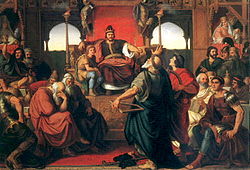

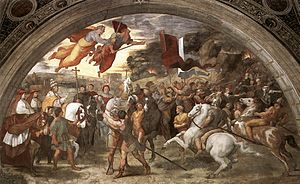
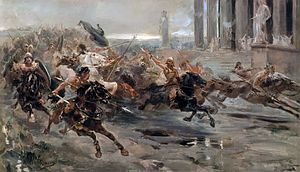

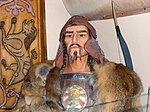
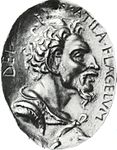


Mga Komento
Mag-post ng isang Komento